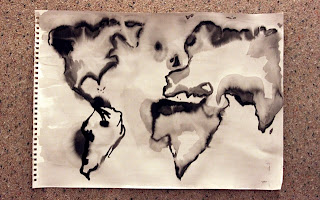So last week, I created 3 tiny (high in contrast to my 4x3m map) ping-pong ball sized globes, each with different regions of the world on. I painted the so called 'first world' on one, 'second world' on another and 'third world' on the other. I did this, not because I support this classification system, but because I disagree with it. I wanted to produce something to make people visualise what they are saying. It is not only wrong with an ethical mindset, but in literal terms, it is also incorrect. We are not 3 separate worlds. We are all part of one world, and until we treat it that way, this categorising will continue to exist.
I believe that if everyone worked towards treating the rest of the world with an equal level of respect, there will substantial benefits, and not only for those in poorer environments. I think there needs to be a complete shift in globalization. Instead of societies being driven by capitalism and consumerism, we could use our economies to help countries who have not yet reached a crucial point in development. Under no standards should we convert other cultures into our currently over-developed lifestyle, but bringing them up to a level where overall health, happiness, safety and education is improved, would be a nice priority.
I have learnt that the first, second and third world concept, came about after World War II when capitalist countries were given the title '1st world', communist regions '2nd world' and everywhere else (which included areas of great poverty) was referred to as the '3rd world'. I know that these days, a lot of us have used these terms to talk about different countries, but I want to raise the point that we should not be categorized into different ranks, and that working towards the dismissal of these will be better for everybody.
Powerful stereotypes have developed in which we assume a 'first world' country has the best standards and every 'third world' country is struggling . In actual fact, their are countries included in the 'third world' bracket which are doing very well - India and Brazil being two, and there are huge flaws in America (major '1st world' contributor) that seem quite hidden from peoples attention - their shocking health insurance denials for example.
I don't mean to get so deep with such a small project, but I wanted to represent the classifications by separate, recognisable but unfamiliar globes.
I then experimented with making art that represented the merging together of the worlds - something I understand seems impossible, but with extensive amounts of time, effort and co-operation, I don't think it is out of reach.
References:
The Spirit Level: Why equality is better for everyone, Richard Wilkinson and Kate Pickett, 2009
Aid and Other Dirty Business, Giles Bolton, 2007
http://www.globalissues.org/issue/235/consumption-and-consumerism











No comments:
Post a Comment